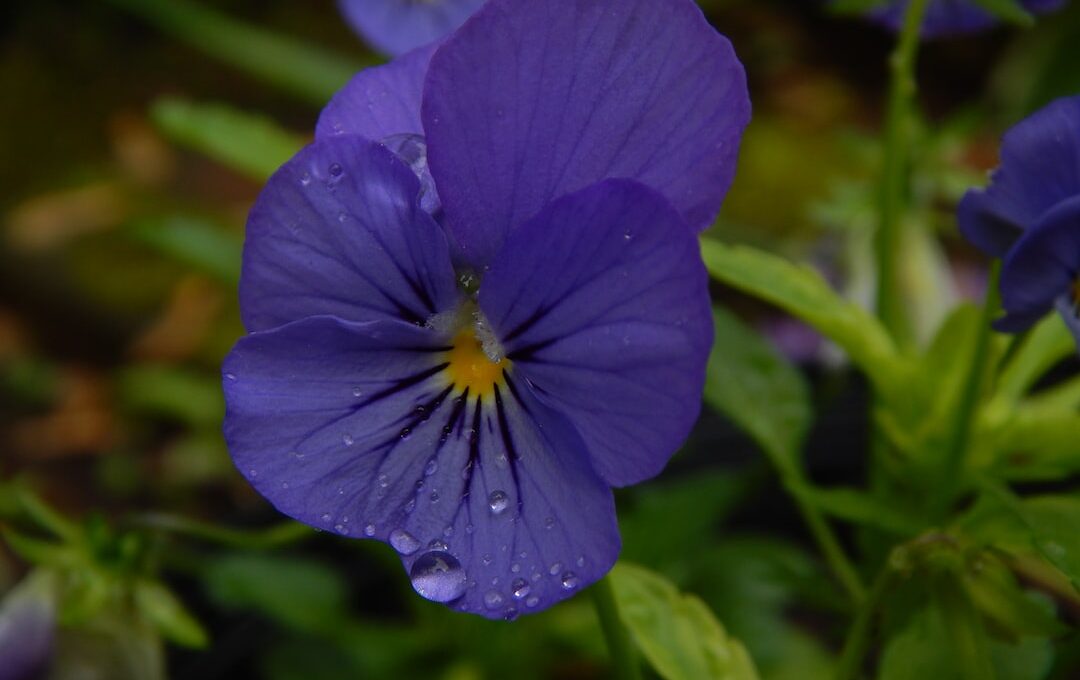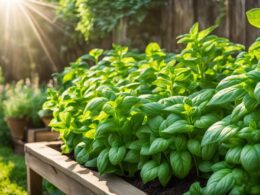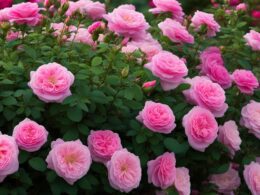Do you love the vibrant colors and delicate blooms of potted pansies? If so, you’re probably wondering how long these beautiful flowers will last in your garden.
Potted pansies can provide you with months of enjoyment, but their lifespan can be influenced by various factors. In this article, we will explore the average lifespan of potted pansies, as well as the factors that can affect their longevity. We will also discuss the signs that indicate your pansies are fading and provide you with valuable tips to extend their lifespan.
Additionally, we will share creative ways to reuse potted pansies once they have withered. Finally, we will showcase some of the most popular varieties of potted pansies, so you can choose the perfect ones for your garden.
With these valuable insights, you can ensure that your potted pansies thrive and bring joy to your outdoor space for as long as possible.
Quick Summary
- Potted pansies typically have a lifespan of 1-2 years.
- The lifespan of potted pansies is influenced by factors such as light, watering, and soil quality.
- Pansies require at least 6 hours of direct sunlight daily and prefer well-draining soil rich in organic matter.
- To extend the lifespan of potted pansies, proper watering, fertilizing, pruning, and protection from extreme weather are essential.
Lifespan of Potted Pansies
Potted pansies, like many other flowering plants, have a lifespan of around one to two years. However, the actual lifespan of your potted pansies can be influenced by several factors affecting their health and longevity.
To ensure that your potted pansies thrive and last as long as possible, there are a few care tips you should keep in mind.
First and foremost, proper watering is crucial for the lifespan of your potted pansies. Overwatering can lead to root rot and other diseases, so be sure to water them only when the top inch of soil feels dry. Additionally, providing well-draining soil and using a pot with drainage holes can help prevent waterlogged roots.
Another important factor to consider is the amount of sunlight your potted pansies receive. These delicate flowers prefer full sun to partial shade, so make sure they get at least six hours of direct sunlight each day. If you’re keeping them indoors, place them near a bright window.
Regular fertilizing is also essential for the health and longevity of your potted pansies. Use a balanced fertilizer every four to six weeks during the growing season to provide them with the necessary nutrients.
Lastly, keep an eye out for pests and diseases, as they can significantly affect the lifespan of your potted pansies. Regularly inspect your plants for any signs of trouble and take appropriate measures to address any issues promptly.
By following these care tips and considering the factors affecting the health of your potted pansies, you can help them live a long and vibrant life, bringing beauty to your home or garden for years to come.
Factors that Affect the Lifespan
Take care of your pansies and they’ll bring color and beauty to your space for an impressive amount of time. The lifespan of potted pansies can vary depending on several factors that affect their growth. By understanding these factors and taking necessary precautions, you can ensure that your pansies thrive and last longer.
Factors Affecting Growth:
-
Light: Pansies require at least 6 hours of direct sunlight each day. Insufficient light can weaken the plants, making them more susceptible to diseases and pests.
-
Watering: Overwatering or underwatering can both be detrimental to potted pansies. It is important to maintain a consistent watering schedule and ensure that the soil is moist but not waterlogged.
-
Soil Quality: Pansies prefer well-draining soil that is rich in organic matter. Poor soil quality can hinder their growth and make them more vulnerable to diseases.
Common Diseases and Pests:
Pansies can be affected by various diseases and pests, including:
-
Powdery mildew: This fungal disease appears as a white powdery coating on the leaves. To prevent it, ensure good air circulation around the plants and avoid overhead watering.
-
Aphids: These small insects feed on the sap of pansies, causing stunted growth and deformed leaves. Regularly inspect your plants and use organic insecticides if necessary.
By considering these factors and taking appropriate measures to prevent diseases and pests, you can extend the lifespan of your potted pansies and enjoy their vibrant beauty for a longer period.
Signs that Your Potted Pansies are Fading
When your potted pansies start to lose their vibrant colors and droop, it’s a clear sign that they’re fading. It’s important to pay attention to these signs, as they can indicate that your pansies are in distress and need immediate attention.
One of the signs of wilting is when the leaves of your pansies start to turn yellow or brown. This can happen due to overwatering or underwatering. If you notice that the soil is constantly wet or dry, it’s important to adjust your watering routine accordingly.
Another reason for discoloration is nutrient deficiency. Pansies require a balanced fertilizer to stay healthy and vibrant. If you notice that the leaves are pale or have dark spots, it’s a sign that they’re lacking essential nutrients. In this case, it’s recommended to feed your pansies with a slow-release fertilizer designed for flowering plants.
Additionally, extreme weather conditions can also cause fading in your potted pansies. If the temperature is too hot or too cold, it can stress the plants and lead to wilting and discoloration. To protect your pansies from extreme weather, consider moving them to a more suitable location or providing them with shade or insulation.
By being aware of these signs and taking appropriate actions, you can help prolong the lifespan of your potted pansies and enjoy their beauty for a longer period of time.
Tips to Extend the Lifespan
To extend the lifespan of your potted pansies, there are a few key points to keep in mind.
First, make sure to use proper watering techniques, such as watering deeply and evenly to keep the soil moist but not waterlogged.
Second, regularly fertilize and prune your pansies to promote healthy growth and prevent disease.
Lastly, protect your pansies from extreme weather conditions by providing shade or covering them during hot summer days or protecting them from frost in the winter.
Proper Watering Techniques
Watering your potted pansies properly will ensure their delicate blooms flourish and fill your heart with joy. When it comes to indoor versus outdoor pansies, the watering techniques differ slightly. For indoor pansies, it’s important to keep the soil consistently moist, but not soggy. Avoid overwatering, as this can lead to root rot and the demise of your pansies. Outdoor pansies, on the other hand, require less frequent watering, as they can benefit from natural rainfall. However, be sure to water them deeply when the soil feels dry to the touch. It’s crucial to avoid common mistakes in watering, such as shallow watering or using excessive force that may damage the fragile blooms. Remember, proper watering techniques will keep your potted pansies thriving and bring you endless delight.
| Mistake | Consequence | Solution |
|---|---|---|
| Shallow watering | Pansies develop shallow roots and become more susceptible to drought | Water deeply, allowing the water to penetrate the soil |
| Overwatering | Root rot and wilting of the pansies | Ensure proper drainage and allow the soil to dry slightly between waterings |
| Using excessive force | Damaged blooms and broken stems | Gently water the pansies, directing the flow towards the base of the plant |
Fertilizing and Pruning
Now that you understand the importance of proper watering techniques for your potted pansies, let’s move on to the next step in caring for these delicate flowers: fertilizing and pruning.
Fertilizing your pansies is crucial for their overall health and longevity. By providing them with the right nutrients, you can ensure they have the energy to bloom beautifully.
When it comes to pruning, it may seem counterintuitive to cut back your plants, but it actually has many benefits. Pruning helps promote new growth, prevents the plants from becoming leggy, and improves air circulation, reducing the risk of diseases.
To make sure your pansies thrive, here are three key tips to keep in mind:
- Use a balanced fertilizer specifically formulated for flowering plants.
- Prune your pansies regularly to maintain their shape and encourage more blooms.
- Dispose of any dead or diseased plant material, as it can attract pests and harm your other plants.
By following these fertilizing and pruning techniques, you’ll help your potted pansies stay strong and vibrant for as long as possible.
Protecting from Extreme Weather
During harsh weather conditions, such as heavy rain or scorching heat, it’s crucial to shield your delicate pansies from potential damage. Potted pansies are susceptible to pests and diseases, which can further weaken them during extreme weather.
To protect your potted pansies from pests, make sure to regularly inspect the plants for any signs of infestation, such as holes in the leaves or webs. If you notice any pests, use an organic insecticide to eliminate them. Additionally, avoid overwatering your pansies as this can attract pests.
To protect your pansies from diseases, ensure that the pots have good drainage to prevent waterlogged soil, which can lead to root rot. Also, avoid overcrowding the pots as this can create a humid environment that promotes disease.
By taking these precautions, you can keep your potted pansies safe and healthy during extreme weather.
Reviving Withered Potted Pansies
To bring back life to your withered potted pansies, it’s essential to provide them with proper care and attention. Reviving withered potted pansies can be a delicate task, but by following a few simple steps, you can give them a fighting chance to bloom again.
First, make sure you’re providing your pansies with the right amount of water. Overwatering can lead to root rot, while underwatering can cause them to dry out further. Check the soil regularly and water only when it feels dry to the touch. Remember to water at the base of the plant, avoiding the leaves to prevent fungal diseases.
Next, consider the temperature. Potted pansies are hardy plants, but they can struggle in extreme cold or heat. If you live in an area with harsh winters, consider bringing your pansies indoors or providing them with a protective covering. If the weather’s too hot, move them to a shaded location to prevent wilting.
Lastly, ensure your pansies are getting enough sunlight. These plants thrive in bright, indirect light. Place them in an area where they can receive at least 4-6 hours of sunlight each day.
By caring for your potted pansies during winter and providing them with the necessary attention, you can revive your withered plants and enjoy their beautiful blooms once again. Remember, with a little love and care, your pansies will thank you by flourishing.
What is the Lifespan of Potted Sunflowers Compared to Potted Pansies?
The potted sunflowers lifespan differs from that of potted pansies. Potted sunflowers generally have a shorter lifespan, typically lasting for a few weeks or up to a couple of months. On the other hand, potted pansies can thrive for a longer duration, with their lifespan ranging from a few months to even a year if properly cared for.
Creative Ways to Reuse Potted Pansies
Get ready to unleash your creativity and discover amazing ways you can breathe new life into your beautiful, blooming potted pansies! Don’t let those wilted flowers go to waste – there are plenty of creative repurposing ideas and exciting DIY projects you can do with them.
Here are some safe and fun ways to reuse your potted pansies:
-
Pressed Flower Art: Preserve the beauty of your pansies by pressing them between the pages of a heavy book. Once dried, use them to create beautiful artwork, such as framed botanical prints or handmade greeting cards.
-
Pansy Potpourri: Dry out your pansies and mix them with other fragrant herbs and flowers to create a delightful potpourri. Place it in a decorative bowl or sachets to freshen up your home.
-
Miniature Fairy Gardens: Transform your potted pansies into a whimsical fairy garden. Use small figurines, rocks, and moss to create a magical landscape. The pansies will add a pop of color and charm to your mini oasis.
-
Pansy-Infused Oil: Infuse your pansies in oil to create a scented oil that can be used for massages or as a natural perfume. Simply place the flowers in a jar and cover them with a carrier oil, such as almond or jojoba oil. Let it sit for a few weeks, then strain and enjoy the fragrant oil.
These creative repurposing ideas and DIY projects will not only extend the life of your potted pansies but also bring a touch of beauty and creativity into your life. So go ahead, let your imagination run wild and explore the endless possibilities!
Popular Varieties of Potted Pansies
Explore the vibrant world of popular potted pansy varieties and immerse yourself in a kaleidoscope of colors and patterns. Potted pansies are known for their stunning blooms and are a favorite among garden enthusiasts. These charming flowers come in a variety of colors, ranging from deep purples and blues to vibrant yellows and oranges. Some popular pansy colors include lavender, violet, yellow, and white. These colors can add a beautiful touch to any garden or indoor space.
Caring for potted pansies is relatively easy, making them a popular choice for both beginner and experienced gardeners. These flowers thrive in cool weather and prefer well-draining soil. It’s important to keep the soil moist but not waterlogged, as overwatering can lead to root rot. Regular deadheading, or removing spent blooms, will encourage continuous flowering. Potted pansies also benefit from occasional fertilization with a balanced, slow-release fertilizer.
To help you choose the perfect potted pansy variety for your space, here is a table showcasing some popular varieties and their characteristics:
| Variety | Color | Height | Features |
|---|---|---|---|
| ‘Delta’ | Various colors | 6-8 in | Large blooms, heat tolerant |
| ‘Matrix’ | Various colors | 6-8 in | Compact, early blooming |
| ‘Majestic’ | Purple | 6-8 in | Ruffled petals, cold tolerant |
| ‘Cool Wave’ | Various colors | 4-6 in | Trailing habit, excellent in containers |
So dive into the world of potted pansies and enjoy their beauty and charm. With their vibrant colors and easy care, they are sure to bring joy to your garden or indoor space.
Frequently Asked Questions
Where can I buy potted pansies?
To find potted pansies, the best suppliers are garden centers, nurseries, and online retailers. Look for reputable sellers who prioritize quality and safety. Check customer reviews and ask for guidance to ensure a satisfying and secure purchase.
How often should potted pansies be watered?
To care for potted pansies during the winter, water them when the top inch of soil feels dry. Avoid overwatering by allowing the soil to dry out between waterings. This helps prevent root rot and ensures the safety of your plants.
Can potted pansies survive in cold weather?
To protect potted pansies from freezing temperatures, place them in a sheltered area or cover them with a frost cloth. With proper care, potted pansies can survive cold weather and continue to bloom beautifully.
What type of soil is best for potted pansies?
The best soil for potted pansies is well-draining potting mix. It provides the ideal conditions for their growth and ensures their safety. Avoid heavy or compacted soil to prevent root rot and allow for proper water drainage.
Can potted pansies be planted in the ground after they have finished blooming?
Yes, potted pansies can be replanted in the ground after they finish blooming. To care for them, make sure to provide well-drained soil, water regularly, and give them enough sunlight.
Conclusion
In conclusion, potted pansies can last for several months with proper care and attention. Factors such as temperature, sunlight, watering, and fertilization can greatly affect their lifespan. If you notice signs of fading, such as wilting or yellowing leaves, it’s important to take immediate action to revive them.
By following tips like deadheading and providing adequate water and nutrients, you can extend the lifespan of your potted pansies. And remember, even after they have faded, you can find creative ways to reuse them in your garden or home décor.
So go ahead and enjoy these popular and beautiful varieties of potted pansies for as long as possible!









